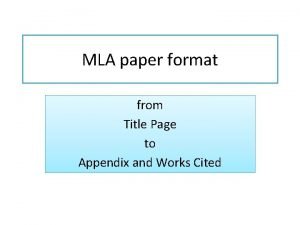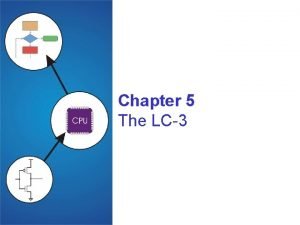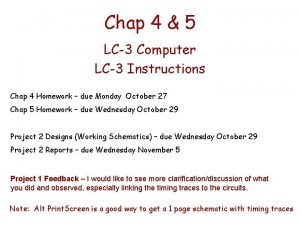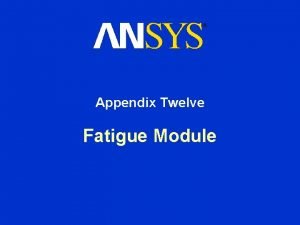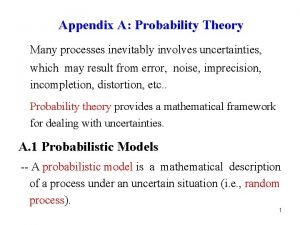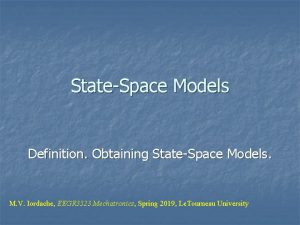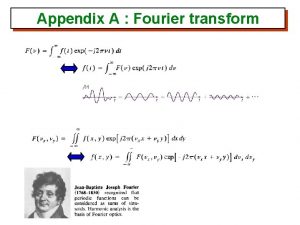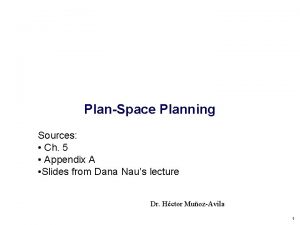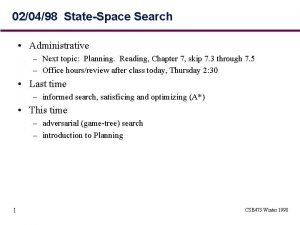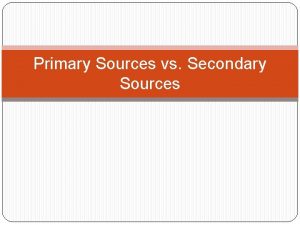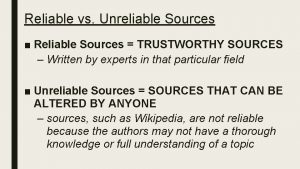StateSpace Planning Sources Ch 3 Appendix A Slides































- Slides: 31

State-Space Planning Sources: • Ch. 3 • Appendix A • Slides from Dana Nau’s lecture Dr. Héctor Muñoz-Avila

Reminder: Some Graph Search Algorithms (I) G = (V, E) 10 Edges: set of pairs of vertices (v, v’) Vertices B 4 Z 16 9 C A 20 G 8 F 6 D 6 24 E 20 • Breadth-first search: Use a queue (FIFO policy) to control order of visits • State-firsts search: Use an stack (FILA policy) to control order of visits • Best-first search: minimize an objective function f(): e. g. , distance. Djikstra • Greedy search: select best local f() and “never look back” • Hill-climbing search: like greedy search but every node is a solution • Iterative deepening: exhaustively explore up to depth i

State-Space Planning A C B B C A B A B C C B A C A B C A • Search is performed in the state space • State space • V: set of states • E: set of transitions A (s, a)) B B C C A B C B A C • But: computed graph is a subset of state space • Remember the number of states for DWR states? • Search modes: • Forward • Backward

Nondeterministic Search • The oracle definition: given a choice between possible transitions, there is a device, called the oracle, that always chooses the transition that leads to a state satisfying the goals. . . … . . . “current state” . . . Oracle chooses this transition because it leads to a favorable state • Alternative definition (book): parallel computers

goals+(g) s and goals–(g) s = Forward Search satisfied take c 3 take c 2 move r 1 … …

Soundness and Completeness • A planning algorithm A can be sound, complete, and admissible • Soundness: Ø Deterministic: Given a problem and A returns P failure then P is a solution for the problem Ø Nondeterministic: Every plan returned by A is a solution • Completeness: Ø Deterministic: Given a solvable problem then A returns P failure Ø Nondeterministic: Given a solvable problem then A returns a solution • Admissible: If there is a measure of optimality, and a solvable problem is given, then A returns an optimal solution • Result: Forward-search is sound and complete Ø Proof: …

Reminder: Plans and Solutions • Plan: any sequence of actions = a 1, a 2, …, an such that each ai is a ground instance of an operator in O • The plan is a solution for P=(O, s 0, g) if it is executable and achieves g Ø i. e. , if there are states s 0, s 1, …, sn such that • (s 0, a 1) = s 1 • (s 1, a 2) = s 2 • … Example of a deterministic variant of Forward-search that is not • (sn– 1, an) = sn sound? • sn satisfies g Dana Nau: Lecture slides for Automated Planning Licensed under the Creative Commons Attribution-Non. Commercial-Share. Alike License: http: //creativecommons. org/licenses/by-nc-sa/2. 0/

Deterministic Implementations • Some deterministic implementations s 1 a 1 s 4 of forward search: a 4 Ø breadth-first search s 0 sg s 2 a 2 Ø depth-first search s 5 … a 5 Ø best-first search (e. g. , A*) a 3 s 3 Ø greedy search • Breadth-first and best-first search are sound and complete Ø But they usually aren’t practical because they require too much memory So why they are typically not used? Ø Memory requirement is exponential in the length of the solution • In practice, more likely to use depth-first search or greedy search Ø Worst-case memory requirement is linear in the length of the solution Ø In general, sound but not complete • But classical planning has only finitely many states • Thus, can makecan depth-first search complete by doing loop. How we make it complete? checking Dana Nau: Lecture slides for Automated Planning Licensed under the Creative Commons Attribution-Non. Commercial-Share. Alike License: http: //creativecommons. org/licenses/by-nc-sa/2. 0/

Another domain: The Blocks World • • Infinitely wide table, finite number of children’s blocks Ignore where a block is located on the table A block can sit on the table or on another block Want to move blocks from one configuration to another Ø e. g. , a d initial state c a b b e goal c • Can be expressed as a special case of DWR Ø But the usual formulation is simpler

Classical Representation: Symbols • Constant symbols: d Ø The blocks: a, b, c, d, e c e • Predicates: a b Ø ontable(x) - block x is on the table Ø on(x, y) - block x is on block y Ø clear(x) - block x has nothing on it Ø holding(x) - the robot hand is holding block x Ø handempty - the robot hand isn’t holding anything Dana Nau: Lecture slides for Automated Planning Licensed under the Creative Commons Attribution-Non. Commercial-Share. Alike License: http: //creativecommons. org/licenses/by-nc-sa/2. 0/

Classical Operators unstack(x, y) Precond: on(x, y), clear(x), handempty Effects: ~on(x, y), ~clear(x), ~handempty, holding(x), clear(y) stack(x, y) Precond: holding(x), clear(y) Effects: ~holding(x), ~clear(y), on(x, y), clear(x), handempty pickup(x) Precond: ontable(x), clear(x), handempty Effects: ~ontable(x), ~clear(x), ~handempty, holding(x) putdown(x) Precond: holding(x) Effects: ~holding(x), ontable(x), clear(x), handempty c a b c a c b b Dana Nau: Lecture slides for Automated Planning Licensed under the Creative Commons Attribution-Non. Commercial-Share. Alike License: http: //creativecommons. org/licenses/by-nc-sa/2. 0/

Branching Factor of Forward Search a 1 a 2 a 3 initial state … a 50 a 3 goal • Forward search can have a very large branching factor Ø E. g. , many applicable actions that don’t progress toward goal • Why this is bad: Ø Deterministic implementations can waste time trying lots of irrelevant actions • Need a good heuristic function and/or pruning procedure Ø Chad and Hai are going to explain how to do this

Backward Search • For forward search, we started at the initial state and computed state transitions Ø new state = (s, a) • For backward search, we start at the goal and compute inverse state transitions Ø new set of subgoals = – 1(g, a) • To define -1(g, a), must first define relevance: Ø An action a is relevant for a goal g if • a makes at least one of g’s literals true – g effects(a) ≠ • a does not make any of g’s literals false – g+ effects–(a) = and g– effects+(a) = How do we write this formally? Dana Nau: Lecture slides for Automated Planning Licensed under the Creative Commons Attribution-Non. Commercial-Share. Alike License: http: //creativecommons. org/licenses/by-nc-sa/2. 0/

Inverse State Transitions • If a is relevant for g, then Ø – 1(g, a) = (g – effects+(a)) precond(a) • Otherwise – 1(g, a) is undefined • Example: suppose that Ø g = {on(b 1, b 2), on(b 2, b 3)} Ø a = stack(b 1, b 2) • What is – 1(g, a)? • What is – 1(g, a) = {s : (s, a) satisfies g}?

How about using – 1(g, a) instead of – 1(g, a)? s 0 g 4 a 4 g 1 g 2 g 5 a 1 a 2 a 5 g 3 a 3 Dana Nau: Lecture slides for Automated Planning Licensed under the Creative Commons Attribution-Non. Commercial-Share. Alike License: http: //creativecommons. org/licenses/by-nc-sa/2. 0/ g 0

Efficiency of Backward Search a 1 a 2 a 3 initial state … a 50 a 3 goal • Backward search can also have a very large branching factor Ø E. g. , many relevant actions that don’t regress toward the initial state Compared with forward search? • As before, deterministic implementations can waste lots of time trying all of them Dana Nau: Lecture slides for Automated Planning Licensed under the Creative Commons Attribution-Non. Commercial-Share. Alike License: http: //creativecommons. org/licenses/by-nc-sa/2. 0/

Lifting p(a, a) foo(x, y) precond: p(x, y) effects: q(x) foo(a, a) p(a, b) foo(a, b) p(a, c) q(a) foo(a, c) … • Can reduce the branching factor of backward search if we partially instantiate the operators Ø this is called lifting foo(a, y) p(a, y) q(a) Dana Nau: Lecture slides for Automated Planning Licensed under the Creative Commons Attribution-Non. Commercial-Share. Alike License: http: //creativecommons. org/licenses/by-nc-sa/2. 0/

Lifted Backward Search • More complicated than Backward-search Ø Have to keep track of what substitutions were performed • But it has a much smaller branching factor Dana Nau: Lecture slides for Automated Planning Licensed under the Creative Commons Attribution-Non. Commercial-Share. Alike License: http: //creativecommons. org/licenses/by-nc-sa/2. 0/

The Search Space is Still Too Large • Lifted-backward-search generates a smaller search space than Backward-search, but it still can be quite large Ø Suppose a, b, and c are independent, d must precede all of them, and d cannot be executed Ø We’ll try all possible orderings of a, b, and c before realizing there is no solution Ø More about this in Chapter 5 (Plan-Space Planning) d a b d b a d a c d b c d c b goal a Dana Nau: Lecture slides for Automated Planning Licensed under the Creative Commons Attribution-Non. Commercial-Share. Alike License: http: //creativecommons. org/licenses/by-nc-sa/2. 0/

STRIPS • π the empty plan • do a modified backward search from g Ø instead of -1(s, a), each new set of subgoals is just precond(a) Ø whenever you find an action that’s executable in the current state, then go forward on the current search path as far as possible, executing actions and appending them to π Ø repeat until all goals are satisfied π = a 6, a 4 s = ( (s 0, a 6), a 4) g 6 satisfied in s 0 a 6 g 3 a 4 g 5 g 1 a 1 g 2 a 5 g a 3 Dana Nau: Lecture slides for Automated Planning 3 Licensed under the Creative Commons Attribution-Non. Commercial-Share. Alike License: http: //creativecommons. org/licenses/by-nc-sa/2. 0/ current search path g

The Sussman Anomaly a c a b b Initial state c goal • On this problem, STRIPS can’t produce an irredundant solution Dana Nau: Lecture slides for Automated Planning Licensed under the Creative Commons Attribution-Non. Commercial-Share. Alike License: http: //creativecommons. org/licenses/by-nc-sa/2. 0/

The Register Assignment Problem • State-variable formulation: Initial state: {value(r 1)=3, value(r 2)=5, value(r 3)=0} Goal: {value(r 1)=5, value(r 2)=3} Operator: assign(r, v, r’, v’) precond: value(r)=v, value(r’)=v’ effects: value(r)=v’ • STRIPS cannot solve this problem at all Dana Nau: Lecture slides for Automated Planning Licensed under the Creative Commons Attribution-Non. Commercial-Share. Alike License: http: //creativecommons. org/licenses/by-nc-sa/2. 0/

How to Fix? • Several ways: Ø Do something other than state-space search • e. g. , Chapters 5– 8 Ø Use forward or backward state-space search, with domain-specific knowledge to prune the search space • Can solve both problems quite easily this way • Example: block stacking using forward search Dana Nau: Lecture slides for Automated Planning Licensed under the Creative Commons Attribution-Non. Commercial-Share. Alike License: http: //creativecommons. org/licenses/by-nc-sa/2. 0/

Domain-Specific Knowledge • A blocks-world planning problem P = (O, s 0, g) is solvable if s 0 and g satisfy some simple consistency conditions • g should not mention any blocks not mentioned in s 0 • a block cannot be on two other blocks at once • etc. – Can check these in time O(n log n) • If P is solvable, can easily construct a solution of length O(2 m), where m is the number of blocks Ø Move all blocks to the table, then build up stacks from the bottom • Can do this in time O(n) • With additional domain-specific knowledge can do even better …

Additional Domain-Specific Knowledge Axioms • A block x needs to be moved if any of the following is true: Ø s contains ontable(x) and g contains on(x, y) Ø s contains on(x, y) and g contains ontable(x) Ø s contains on(x, y) and g contains on(x, z) for some y≠z Ø s contains on(x, y) and y needs to be moved e c a b d d initial state goal Dana Nau: Lecture slides for Automated Planning Licensed under the Creative Commons Attribution-Non. Commercial-Share. Alike License: http: //creativecommons. org/licenses/by-nc-sa/2. 0/

Domain-Specific Algorithm loop if there is a clear block x such that x needs to be moved and x can be moved to a place where it won’t need to be moved then move x to that place else if there is a clear block x such that x needs to be moved then move x to the table else if the goal is satisfied a then return the plan d b else return failure e c c repeat a b initial state Dana Nau: Lecture slides for Automated Planning Licensed under the Creative Commons Attribution-Non. Commercial-Share. Alike License: http: //creativecommons. org/licenses/by-nc-sa/2. 0/ d goal

Easily Solves the Sussman Anomaly loop if there is a clear block x such that x needs to be moved and x can be moved to a place where it won’t need to be moved then move x to that place else if there is a clear block x such that x needs to be moved then move x to the table else if the goal is satisfied then return the plan a else return failure c b repeat a b initial state c goal

Properties • The block-stacking algorithm: Ø Sound, complete, guaranteed to terminate Ø Runs in time O(n 3) • Can be modified to run in time O(n) Ø Often finds optimal (shortest) solutions Ø But sometimes only near-optimal (Exercise 4. 22 in the book) • PLAN LENGTH for the blocks world is NP-complete Dana Nau: Lecture slides for Automated Planning Licensed under the Creative Commons Attribution-Non. Commercial-Share. Alike License: http: //creativecommons. org/licenses/by-nc-sa/2. 0/

An Actual Application: FEAR. • F. E. A. R. : First Encounter Assault Recon • Here is a video clip • Behavior of opposing NPCs is modeled through STRIPS operators Ø Attack Ø Take cover Ø… • Why? ØOtherwise you would need too build an FSM for all possible behaviours in advance

Planning Operators FSM vs AI Planning FSM: Monster In Sight Patrol Fight No Monster • Patrol ØPreconditions: No Monster ØEffects: patrolled • Fight ØPreconditions: Monster in sight ØEffects: No Monster A resulting plan: Monster in sight Fight No Monster Patrol patrolled Neither is more powerful than the other one

But Planning Gives More Flexibility • “Separates implementation from data” --- Orkin Planning Operators reasoning • Patrol ØPreconditions: No Monster ØEffects: patrolled • Fight ØPreconditions: Monster in sight ØEffects: No Monster … knowledge Many potential plans: Fight Fight Patrol Patrol … If conditions in the state change making the current plan unfeasible: replan!
 Slides appendix
Slides appendix Print and web sources
Print and web sources Water resources
Water resources A small child slides down the four frictionless slides
A small child slides down the four frictionless slides A spring loaded gun shoots a plastic ball
A spring loaded gun shoots a plastic ball Strategic planning vs tactical planning
Strategic planning vs tactical planning Planning balance sheet in urban planning
Planning balance sheet in urban planning Role segmentation workforce planning
Role segmentation workforce planning N planning
N planning Perencanaan kapasitas dan agregat
Perencanaan kapasitas dan agregat Short medium and long term planning in education
Short medium and long term planning in education Language policy and planning ppt
Language policy and planning ppt Aggregate planning is capacity planning for
Aggregate planning is capacity planning for Aggregate planning is capacity planning for
Aggregate planning is capacity planning for Appendix sample
Appendix sample Appendices in report
Appendices in report Appendix paper mla
Appendix paper mla Marvel universe appendix
Marvel universe appendix Appendix venous drainage
Appendix venous drainage Appendix powerpoint template
Appendix powerpoint template Ileocal
Ileocal Lig. hepatogastricum
Lig. hepatogastricum Appendix in marketing plan
Appendix in marketing plan Dss risk management framework
Dss risk management framework Rmf continuous monitoring
Rmf continuous monitoring Lc-3
Lc-3 Lc3 computer
Lc3 computer Strain life parameters ansys
Strain life parameters ansys Activity 2: reflection
Activity 2: reflection Appendix writing
Appendix writing Total probability theorem
Total probability theorem Nursing interventions for appendicitis
Nursing interventions for appendicitis
















